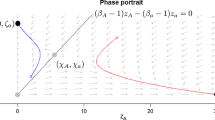Abstract
When there is a variation in the quality of males in a population, multiple mating can lead to an increase in the genetic fitness of a female by reducing the variance of the progeny number. The extent of selective advantage obtainable by this process is investigated for a population subdivided into structured demes. It is seen that for a wide range of model parameters (deme size, distribution of male quality, local resource level), multiple mating leads to a considerable increase in the fitness. Frequency-dependent selection or a stable coexistence between polyandry and monandry can also result when the possible costs involved in multiple mating are taken into account.
Similar content being viewed by others
References
Cole B J 1983 Multiple mating and the evolution of social behaviour in Hymenoptera.Behav. Ecol. Sociobiol. 12: 191–201
Crozier R H 1977 Evolutionary genetics of the Hymenoptera.Anini. Rev. Entomol. 22: 263–288
Crozier R H and Page R E 1985 On being the right size: male contributions and multiple mating in social Hymenoptera.Behav. Ecol. Sociobiol. 18: 105–115
Drummond B A III 1984 Multiple mating and sperm competition in lepidoptera. InSperm competition and the evolution of animal mating systems (ed.) R L Smith (Orlando, Fl: Academic Press) pp. 291–370
Gibson R M and Jewel P A 1982 Semen quality, female choice and multiple mating in domestic sheep: A test of Triver’s sexual competence hypothesis.Behaviour 80: 9–31
Gillespie J H 1974 Natural selection for within generation variance in offspring number.Genetics 76: 601–606
Gillespie J H 1977 Natural selection for variance in offspring numbers: A new evolutionary principle.Am. Nat. 110: 1010–1014
Halliday T and Arnold S J 1987 Multiple mating by females: a perspective from quantitive genetics.Anim. Behav. 35: 939–941
Knowlton N and Greenwell R 1984 Male sperm competition avoidance mechanisms: the influence of female interests. InSperm competition and the evolution of animal mating systems (ed.) R L Smith (Orlando, Fl: Academic Press) pp. 61–84
Loman J Madsen T and Hakansson T 1988 Increased fitness from multiple matings, and genetic heterogeneity: a model of a possible mechanism.Oikos 52: 69–72
Parker G A 1970 Sperm competition and its evolutionary consequences in the insects.Biol. Rev. 45: 525–567
Parker G A 1984 Sperm competition and the evolution of animal mating systems. InSperm competition and the evolution of animal mating systems (ed.) R L Smith (Orlando, Fl: Academic Press) pp. 1–60
Sherman P W, Seeley Thomas D and Reeve Hudson K 1988 Parasites, pathogens and polyandry in social hymenoptera.Am. Nat. 131: 602–610
Smith R L (ed.) 1984Sperm competition and the evolution of animal mating systems (Orlando, Fl: Academic Press)
Williams G C 1975Sex and evolution (New Jersey: Princeton University Press)
Wilson D S 1982The natural selection of populations and communities (Menlo Park, CA: Benjamin-Cummings)
Author information
Authors and Affiliations
Rights and permissions
About this article
Cite this article
Joshi, N.V. Evolution of polyandry by reduction in progeny number variance in structured populations. J. Genet. 67, 161–171 (1988). https://doi.org/10.1007/BF02927827
Received:
Issue Date:
DOI: https://doi.org/10.1007/BF02927827




